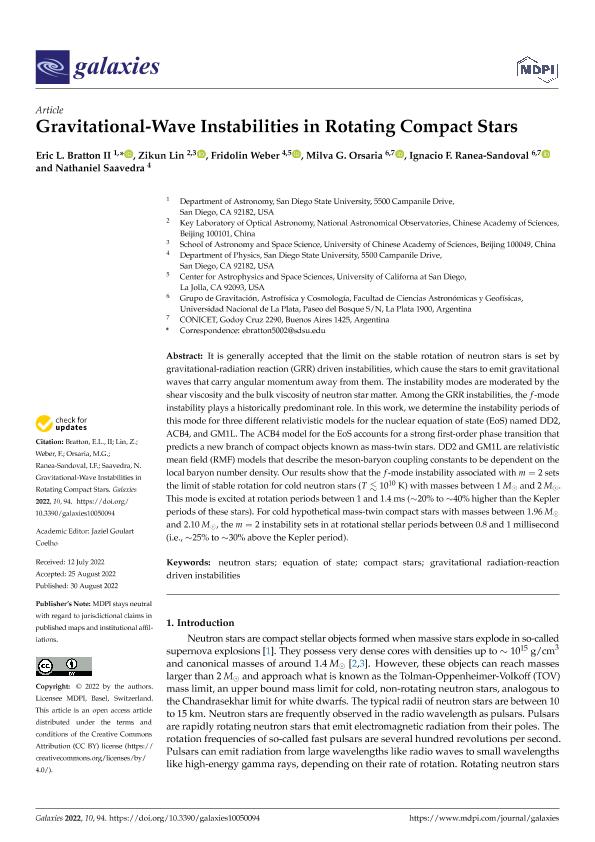Artículo
Gravitational-Wave Instabilities in Rotating Compact Stars
Bratton, Eric L.; Lin, Zikun; Weber, Fridolin; Orsaria, Milva Gabriela ; Ranea Sandoval, Ignacio Francisco
; Ranea Sandoval, Ignacio Francisco ; Saavedra, Nathaniel
; Saavedra, Nathaniel
 ; Ranea Sandoval, Ignacio Francisco
; Ranea Sandoval, Ignacio Francisco ; Saavedra, Nathaniel
; Saavedra, Nathaniel
Fecha de publicación:
10/2022
Editorial:
MDPI
Revista:
Galaxies
ISSN:
2075-4434
Idioma:
Inglés
Tipo de recurso:
Artículo publicado
Clasificación temática:
Resumen
It is generally accepted that the limit on the stable rotation of neutron stars is set by gravitational-radiation reaction (GRR) driven instabilities, which cause the stars to emit gravitational waves that carry angular momentum away from them. The instability modes are moderated by the shear viscosity and the bulk viscosity of neutron star matter. Among the GRR instabilities, the f-mode instability plays a historically predominant role. In this work, we determine the instability periods of this mode for three different relativistic models for the nuclear equation of state (EoS) named DD2, ACB4, and GM1L. The ACB4 model for the EoS accounts for a strong first-order phase transition that predicts a new branch of compact objects known as mass-twin stars. DD2 and GM1L are relativistic mean field (RMF) models that describe the meson-baryon coupling constants to be dependent on the local baryon number density. Our results show that the f-mode instability associated with (Formula presented.) sets the limit of stable rotation for cold neutron stars ((Formula presented.) K) with masses between (Formula presented.) and (Formula presented.). This mode is excited at rotation periods between 1 and 1.4 ms (∼20% to ∼40% higher than the Kepler periods of these stars). For cold hypothetical mass-twin compact stars with masses between (Formula presented.) and (Formula presented.), the (Formula presented.) instability sets in at rotational stellar periods between 0.8 and 1 millisecond (i.e., ∼25% to ∼30% above the Kepler period).
Archivos asociados
Licencia
Identificadores
Colecciones
Articulos(CCT - LA PLATA)
Articulos de CTRO.CIENTIFICO TECNOL.CONICET - LA PLATA
Articulos de CTRO.CIENTIFICO TECNOL.CONICET - LA PLATA
Citación
Bratton, Eric L.; Lin, Zikun; Weber, Fridolin; Orsaria, Milva Gabriela; Ranea Sandoval, Ignacio Francisco; et al.; Gravitational-Wave Instabilities in Rotating Compact Stars; MDPI; Galaxies; 10; 5; 10-2022; 1-23
Compartir
Altmétricas



